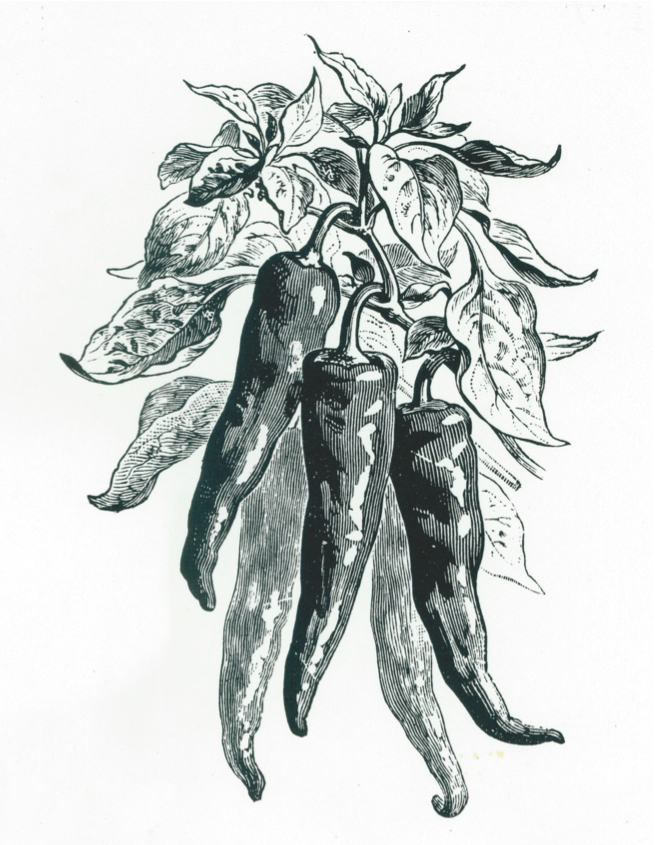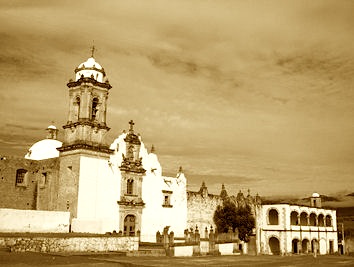 By Dave DeWitt
By Dave DeWitt
Aztec Chiles
In 1529, Bernardino de Sahagún, a Spanish Franciscan friar living in Nueva España (Mexico) noted that the Aztecs ate hot red or yellow chile peppers in their hot chocolate and in nearly every dish they prepared! Fascinated by the Aztec’s constant use of a previously unknown spice, Sahagún documented this fiery cuisine in his classic study, Historia General de las Cosas de la Nueva España, now known as the Florentine Codex. His work indicates that of all the pre-Columbian New World civilizations, it was the Aztecs who loved chile peppers the most.
The market places of ancient Mexico overflowed with chile peppers of all sizes and shapes, and Sahagún wrote they included “hot green chiles, smoked chiles, water chiles, tree chiles, beetle chiles, and sharp-pointed red chiles.” In addition to some twenty varieties of chillis, as the pungent pods were called in the Náhuatl language, vendors sold strings of red chiles (modern ristras), pre-cooked chiles, and “fish chiles,” which were the earliest known forms of ceviche, a method of preserving fish without cooking. This technique places the fish in a marinade of an acidic fruit juice and chile peppers.
Other seafood dishes were common as well in ancient Mexico. “They would eat another kind of stew, with frogs and green chile,” Sahagún recorded, “and a stew of those fish called axolotl with yellow chile. They also used to eat a lobster stew which is very delicious.” Apparently the Aztecs utilized every possible source of protein. The friar noted such exotic variations as maguey worms with a sauce of small chiles, newt with yellow chiles, and tadpoles with chiltecpitl.
Father Sahagún, one of the first behavioral scientists, also noted that chiles were revered as much as sex by the ancient Aztecs. While fasting to appease their rather bloodthirsty gods, the priests required two abstentions by the faithful: sexual relations and chile peppers.
Chocolate and chiles were commonly combined in a drink called chicahuatl, which was usually reserved for the priests and the wealthy. The Aztec versions of tamales often used banana leaves as a wrapper to steam combinations of masa dough, chicken, and the chiles of choice. Sahagún wrote that there were two types of sauces called “chilemollis”: one with red chile and tomatoes, and the other with yellow chile and tomatoes. These chilemollis eventually became the savory mole sauces for which Mexican cuisine is justly famous.
Aztec cookery was the basis for the Mexican food of today, and, in fact, many Aztec dishes have lasted through the centuries virtually unchanged. Since oil and fat were not generally used in cooking, the foods were usually roasted, boiled, or cooked in sauces. Like the Mayas, the Aztecs usually began the day with a cup of atole spiced with chile peppers.
The main meal was served at midday and usually consisted of tortillas with beans and a salsa made with chiles and tomatoes.
The salsas were usually made by grinding the ingredients between two hand-held stones, the molcajetes. Even today, the same technique is used in Indian villages throughout Mexico and Central America. A remarkable variety of tamales were also served for the midday meal. They were stuffed with fruits such as plums, pineapple, or guava; with game meat such as deer or turkey; or with seafood such as snails or frogs. Whole chile pods were included with the stuffing, and after steaming, the tamales were often served with a cooked chile sauce.
It was this highly sophisticated chile cuisine which the Spanish encountered during their conquest of Mexico. Christopher Columbus “discovered” chile peppers in the West Indies on his first voyage to the New World. In his journal for 1493, he wrote, “Also there is much ají, which is their pepper, and the people won’t eat without it, for they find it very wholesome. One could load fifty caravels a year with it in Hispaniola.”
Dr. Diego Chanca, the fleet physician for Columbus on his second voyage, wrote in his journal that the Indians seasoned manioc and sweet potatoes with ají, and that it was one of their principal foods. Of course, both Columbus and his doctor believed that they had reached the Spice Islands, the East Indies. Not only did Columbus misname the Indians, he also mistook chiles for black pepper, thus giving them the inaccurate name “pepper.” But he did one thing right–he transported chile seeds back to Europe after his first voyage, which began the chile conquest of the rest of the world.
Explorers who followed Columbus to the New World soon learned that chiles were an integral part of the Indians’ culinary, medical, and religious lives. In 1526, just thirty-four years after Columbus’ first excursion, El Capitán Gonzalo de Oviedo noted that on the Spanish Main, “Indians everywhere grow it in gardens and farms with much diligence and attention because they eat it continuously with almost all their food.”
Bernabe Cobo, a naturalist and historian who traveled throughout Central and South America in the early seventeenth century, estimated that there were at least forty different varieties. He wrote that there were “some as large as limes or large plums; others, as small as pine nuts or even grains of wheat, and between the two extremes are many different sizes. No less variety is found in color…and the same difference is found in form and shape.”
The Aztec market in the capital, Tenochtitlan, contained a large number of chiles, and most of those had been collected as tribute, a form of taxation used by the Toltecs and Aztecs and later adopted by the Spanish. The payers of the tribute were the macehuales, the serfs or commoners; the collectors were Aztec officials, or later on, officials who worked for the Spanish. The tribute consisted of locally produced goods or crops that were commonly grown, and the tribute of each village was recorded in boxes on codices of drawn or painted pictographs.
According to many sources, chiles were one of the most common tribute items. The chiles were offered to the government in several different forms: as fresh or dried pods, as seed, in two hundred-pound bundles, in willow baskets, and in Spanish bushels. After the chile and the rest of the produce was moved to the capital, it was stored in warehouses and closely guarded, and then sold. Chile peppers were considered to be the most valuable of the tributes.
One of the most famous tribute codices is the Matricula de Tributos, which is part of the Mendocino Codex. This codex was compiled for the first viceroy of New Spain, Antonio de Mendoza, who ordered it painted in order to inform the Emperor Charles V of the wealth of what is now Mexico. Glyphs on the codex indicate the tribute paid to the Aztecs by conquered towns just before the Spanish conquest; the towns on one tribute list (in what is now San Luis Potosí) gave 1,600 loads of dry chile to the imperial throne each year!
The Mendocino Codex also reveals an early use of chile peppers as form of punishment. One pictograph shows a father punishing his young son by forcing him to inhale smoke from roasting chiles. The same drawing shows a mother threatening her daughter with the same punishment. Today, the Popolocán Indians who live near Oaxaca punish their children in a similar manner.
Wherever they traveled in the New World, Spanish explorers, particularly non-soldiers, collected and transported chile seeds and thus further spread the different varieties. And not only did they adopt the chile as their own, the Spanish also imported foods that they combined with chiles and other native ingredients to create even more complex chile cuisines.
(Part 1 is here. Part 3 is here.)
Return to the beginning, here.









